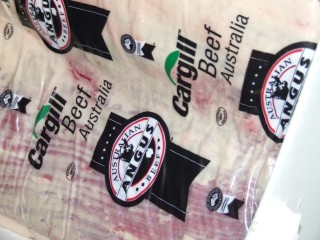Analysis
 All things going according to plan, a major change in the dynamics of the Australian beef industry will occur around September, as processors Teys Brothers and Cargill Beef Australia consummate their marriage.
All things going according to plan, a major change in the dynamics of the Australian beef industry will occur around September, as processors Teys Brothers and Cargill Beef Australia consummate their marriage.
Barring an unlikely challenge by the Foreign Investment Review Board or Australian Competition and Consumer Commission, the merged entity should be trading during the third quarter this year.
The new business will include six plants with a combined daily kill capacity of 6400 head. While that is huge by Australian standards, it should be put into some context: there are individual plants in the US with throughputs about as large.
Neither party was prepared to disclose a purchase price, being a private treaty arrangement between Cargill and the Packer family, but the popular figure being touted in industry and media circles is about A$500m.
While the 50-50 ownership structure announced last Wednesday is less common in business circles than 51:49, Teys chief executive Brad Teys pointed out that a similar agreement worked effectively during the Packer partnership era.
The arrangement tiptoes nicely around the issue that sat behind the scenes during the discussion phase over the past six months: control.
It was impossible to see Teys patriarch, Allan Teys, signing over control of any merged business involving Teys to another – particularly a foreign-based entity. Four generations of the Teys family had spilt blood, sweat and tears forging Australia’s greatest domestically-owned processing entity with a reported turnover last year of $1.2 billion. It wasn’t about to end now.
On the other side, it was impossible to see Cargill, the world’s second largest meat packer, investing a reputed $500m buying into a business in which they were only a minor shareholder.
How the future boardroom process unfolds in any potential deadlock situation is an issue to ponder. It remains unclear whether under the merger terms, the chairman (Allan Teys) will hold a deciding vote.
Rationalisation
The reality in most beef industry mergers is often a series of deep cuts among middle and upper management ranks, as economies-of-scale principles set in. Consider the AMH/Swift example: with one exception, AMH’s entire senior management team lost their jobs when JBS took over in 2009. The same happened with the Tasman purchase.
In the Cargill Teys case, it appears that staff rationalisation will be much less severe, partly because of the geographic distance between the businesses. Cargill Australia chief, Andrew MacPherson, well-regarded across the industry as a versatile and strategic thinker, will move into a specialist role driving the merger process over the next three years.
When applied to beef processing the term rationalisation often also implies closure of some surplus or overlapping production capacity, but that looks like not being the case under Cargill/Teys. Questions have been raised about Biloela (located close to the large Lakes Creek Rockhampton factory) and Naracoorte (potentially overlapping a little with Wagga), but the new stakeholders deny there is any prospect of closures.
Rationalisation, in this case, will allow the new Australian JV to elevate itself into ‘global business’ status, and compete with the biggest and best the world has to offer.
If JBS’s arrival in Australia in 2009 did nothing else, it demonstrated the power of taking a global approach to the meat processing business. What the Teys/Cargill merger is signalling is recognition that that strategy is valid, and is something which can be applied equally well by others.
Mutual benefits
In considering what the merger will bring for Cargill, one has to look no further than the original relationship between Teys and Kerry Packer’s Consolidated Pastoral Holdings.
relationship between Teys and Kerry Packer’s Consolidated Pastoral Holdings.
Kerry simply handed the CMG assets over to Allan Teys (pictured right) and his team, out of due deference to Teys’ unparalleled ability to efficiently and effectively manage and run large packing operations. Rather than trying to beat ‘em, Kerry’s response was to join ‘em.
Cargill’s respect for Teys operational track-record is not dissimilar.
The overwhelming advantage the deal presents for Teys is in the ability to penetrate far-flung international markets like never before. Cargill, internationally, has an elaborate distribution and sales network into which the Teys product can now infiltrate. Just as Swift was able to unearth lucrative markets for picanya (rump cap) for former AMH product in new markets like Chile and Brazil, Cargill will inevitably do the same for Teys.
That’s not to say the Teys master-brand, and the labels that operate beneath it, does not already have an enviable reputation in key markets like Japan, Korea and the EU. It does. But the new alignment will take that to another level, and the impact can only filter down to how competitive the new merged entity can be in the market for Australian cattle.
Lamb parallel
A parallel can be found in another species. Last year Adelaide’s T&R Pastoral, the nation’s second largest sheepmeat processor, bought into importer/distributor Foodcomm International in the US, and bought the former Country Fresh processing assets at Tamworth and Wallangarra. That gave the T&R company an opportunity (both in terms of volume and distribution/marketing) to compete more effectively in chilled lamb on the international stage with the Batistas, following their purchases of Tatiara and Tasman.
Times are certainly changing. One well-credentialed processing industry observer this week said, “If you are running a meatworks in Australia today, you have to be asking yourself, how do I change my business to compete in this globalised environment going forward?”
During a market briefing on Wednesday afternoon, CEO-in-waiting Brad Teys confirmed that the merger provided an opportunity to ramp-up grainfed production, but also extended the range of grass and grainfed product that could be supplied by both companies. Teys/Cargill in combination will hold lotfeeding capacity totalling 47,000 head, making it second only to JBS Australia in size.
Mr Teys told the briefing that new technology and automation would be pursued to further drive processing efficiency following the merger, particularly given access to Cargill’s extensive R&D knowledge base in the US. Information sharing would also focus on issues like boning room yield recovery.
Cargill sees Australia as “good fit”
Cargill spokesman Bruce Blakeman said both companies were committed long-term to the Australian beef industry. Cargill believes that combining Teys and Cargill’s Australian beef business was the best way to grow and better serve its Australian and global customers. The partnership would leverage the strengths of both companies, he said.
While Cargill had recently exited its beef processing interests in Brazil, Australia was not simply a ‘diversion’ of that overseas development into another region, he said.
“Having diverse options for supply to deliver quality product to the rest of the world is one of the benefits in aligning with Teys,” he said.
“It is a really good fit to service this hemisphere, especially. It is much more economical to ship product from Australia to Korea, Japan or the Chinas than it is from our assets in Argentina.”
Cargill Australia general manager Andrew MacPherson was unable to say what impact the JV would have on his company’s exploratory move into Value-Based Marketing, but said in principle, both companies had a shared mindset around transparency and signals travelling rapidly and clearly up and down the value chain. But how that translated into Value-Based Procurement systems would need to be discussed in much greater detail around the JV table.
Mr MacPherson agreed that there might be an opportunity for growth in supply, and range of cuts into the domestic Woolworths organisation, post-merger. Cargill is already a very large supplier into the nation’s largest supermarket group through its Tamworth operations. Any future growth might also be reflected in some down-stream integration, through Teys’ value-adding factory in Brisbane.
“That provides a platform from which to launch and push innovative further-processed products into our strategic partners like Woolworths,” he said.
Win or lose for producers?
So does the merger represent any tangible negative effect on beef producers in the area of livestock competition?
An economist would say that to some extent, the move does potentially change the dynamics of livestock trade in Australia, and that producers need to stay in tune with how that may affect them.
But on balance, at a practical industry level, the reality is that globalisation makes the JV a stronger competitor for livestock, driven by its ability to extract the optimum amount of money for each individual muscle on the world stage. The industry has to be better off, in Beef Central’s opinion.
